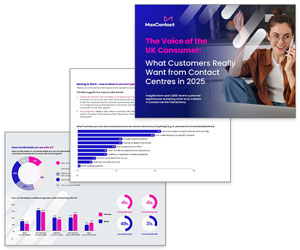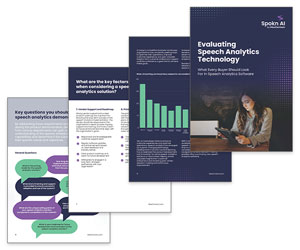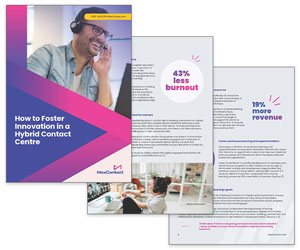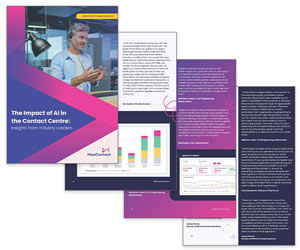Contact centre leaders will surely agree with the Collins Dictionary pick for 2022’s word of the year. After the Covid pandemic transitioned almost seamlessly into the cost of living crisis, the word “permacrisis” feels apt indeed.
For contact centres, that permacrisis has led to cost and staffing pressures over the last 12 months and a new focus on efficiency.
This was also the year when work-from-home strategies that were adopted during the pandemic morphed (in many cases) into permanent hybrid work models. Nobody would claim it’s been an easy 12 months.
So what can we expect in 2023? It’s likely to be another testing year economically, so what does that mean for the contact centre industry?
It’s time to share our contact centre predictions for 2023 as MaxContact has gazed into a crystal ball…
Employee Experience Is the New Customer Experience
Job vacancies rose to record levels in the first half of 2022, and though they have declined a little since, numbers remain high. In other words, it’s a jobseeker’s market. Businesses are having to work harder to recruit and retain talented people.
What are contact centres doing about this, and what will they do in 2023? Certainly, working from home as part of a hybrid model seems here to stay. Firms that don’t offer a flexible working option may miss out.
Talent will also gravitate towards employers that make their jobs easier. For example, agents don’t want to be spending their days on monotonous tasks.
They want to be using their skills and experience to help people. With that in mind, contact centres that offer customers self-serve options and automated payment processes are likely to find it easier to retain staff.
There will also be upwards pressure on wages as the cost of living crisis deepens. One way to deal with that is “small hours” shifts, which means employing at least some agents for peak times only.
This can help cut costs for your business, and may better suit those employees who combine work with other responsibilities.
A Further Push to Digital Interactions
Voice is absolutely the right medium for dealing with complex cases. A helpful and knowledgeable agent will reassure customers that their issue is in good hands. Working on these trickier cases is also what some of your most talented agents signed up for.
But the opposite is also true. Voice is an expensive and resource-intensive channel for more mundane interactions.
For these, webchat and email are better channels, because they allow agents to handle multiple contacts at once. That means more customers get their issues resolved faster, without contact centres increasing headcount and piling on the costs.
With cost pressures mounting, 2023 is likely to see a lot more contact centres take the logical step of adopting integrated omnichannel solutions.
Employee Wellbeing Takes Centre Stage
In 2022 our own research found that the poor mental health of employees is costing contact centres £1 billion every year.
The problem of agent burnout is still very much with us, as employees grapple with a cost-of-living crisis (and a likely uptick in fraught or emotional customer contacts) that is likely to persist right through 2023.
So employee wellbeing will continue to be a growing focus for the sector. It takes many forms, from well-considered shift patterns and observant management to better training and career progression options.
Many employees experience anxiety and stress when they don’t think they are equipped to do the job properly. That’s something contact centre leaders can easily change in 2023.
Convergence Will Be Key in 2023
The next 12 months will see the continued adoption of converged or unified contact centre solutions.
Combining voice, email and web chat, and integrating additional tools like automation, workforce management (WFM) and speech analytics, gives contact centres unique insights into customer behaviour.
That in turn allows them to offer a more efficient and satisfying customer service, and create a proactive rather than reactive customer engagement strategy.
Workflow Automation to Gain Momentum
When you automate customer experience through the smart application of data, proactive engagement becomes possible.
That’s a game changer. It means predicting issues and challenges and acting before customers get in touch. That leads to higher customer satisfaction scores and reduced costs – because prevention is always better than cure.
So how do you automate the customer experience? As technologies converge, innovations like natural language processing (NLP) and AI will leverage huge amounts of data to spot trends and challenges and automate workflows accordingly.
In addition, sentiment analysis allows more personal interactions with customers. This is the pinnacle of contact centre customer experience, and its benefits are likely to become more apparent through 2023 and beyond.
This blog post has been re-published by kind permission of MaxContact – View the Original Article
For more information about MaxContact - visit the MaxContact Website
Call Centre Helper is not responsible for the content of these guest blog posts. The opinions expressed in this article are those of the author, and do not necessarily reflect those of Call Centre Helper.
Author: MaxContact
Published On: 28th Nov 2022
Read more about - Guest Blogs, MaxContact






 MaxContact is customer engagement software that goes above and beyond to build smarter customer experiences. Our platform is packed with powerful features, accessible for businesses large and small, and ensures organisations can operate compliantly.
MaxContact is customer engagement software that goes above and beyond to build smarter customer experiences. Our platform is packed with powerful features, accessible for businesses large and small, and ensures organisations can operate compliantly. 












